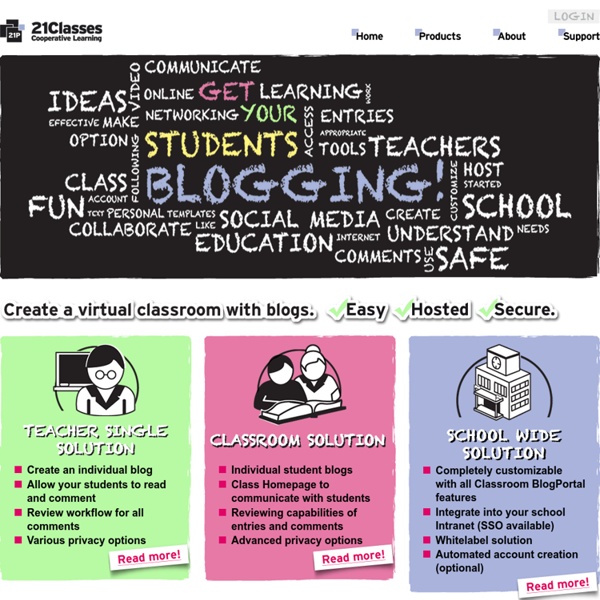



Pinstamatic, create a Pinterest board Places Add a map to your Pinterest board, and when someone clicks it they will be taken to the location in Google Maps. What a great way to show people where you are or where an event is taking place. This is an example of a HTML caption with a link. Stickies Leave a note on your board, maybe to summarize the board itself or just as a message to your followers. How It Works Socrative is a smart student response system that empowers teachers by engaging their classrooms with a series of educational exercises and games. Our apps are super simple and take seconds to login. Socrative runs on tablets, smartphones, and laptops. Teachers login through their device and select an activity which controls the flow of questions and games.
Kathy Cassidy This spring, our class has been working with other classes around the world--sharing and learning together. Several collaborative projects have resulted. The book below is one of the products from that collaboration and contains pages created by various PreK - 2 classrooms from around the world as part of the Flat Classroom Project. Each of the participating classes focused on "A View From the Window" of their school in a different way. Our page (containing photos and text created by the students) is first, but it is fascinating to see what all of the other classes have created as well. Click on the image to see the finished product.
Twenty Tips for Managing Project-Based Learning In honor of Edutopia's 20th anniversary, we're producing a series of Top 20 lists, from the practical to the sublime. 20 Tips for Managing Project-Based Learning 1. Use Social Media One of the best ways to document collaboration and engage students with technology is use social media platforms like Edmodo. Students can use it to share ideas, you as the teacher can use it to formatively assess where students are in terms of products and content knowledge, and it is a great way to have real evidence of collaboration. 2. Education Using PBworks in your academic environments. PBworks hosts over 300,000 educational workspaces, and has helped transform teaching and learning for millions of students, parents and teachers. Educators ranging from major universities like DePaul, school districts like Baltimore County Public Schools and individual teachers trust PBworks as their collaborative learning environment. In your Classroom, Library, District or University Encourage student-centered learning.
25 Ways To Use Twitter In The Classroom, By Degree Of Difficulty How Can We Stop Cheating In Online Courses? 6.11K Views 0 Likes While clearly not every student is trying hard to take the slacker route, it's worth noting that picking out the students trying to take this route gets a little more complicated when you move from taking classes in person to taking classes online. 5 Ways To Have A High-Tech Classroom With What You Already Have 11.45K Views 1 Likes There are a host of ways to use the technology you already have at your fingertips to create a Classroom 2.0.
Headsprout Research based, yet fun and engaging, Headsprout's online software adapts to the needs of each learner. Headsprout offers Headsprout Early Reading for ages 4-7 and Reading Comprehension for ages 7+. Price: $99.95 Takes a non-reader to up a mid-2nd grade reading level in 80 episodes. Teaches the essential skills needed for comprehension in 50 episodes. A Life Our Students Will Never Know Posted by Mrs Kathleen Morris on Tuesday, April 10th 2012 Over the holidays, while attempting to be less “connected”, I’ve been thinking about how much technology seems to be increasingly infused into our day-to-day lives. With laptops, smart phones, iPads, iPods and other portable devices becoming so common place, gadgets are no longer something we go to, they come with us. This clearly brings about many pros and cons. Technology lets us connect and access information more easily, however, being hyperconnected can compromise our health and wellbeing.
Simplek12 Home Browse: By Categories All Administrator ResourcesAssessment & Review Blended LearningBloggingBundles & ToolkitsBusiness EducationClassroom ManagementCollege & Career ReadinessCommon CoreCommunication & CollaborationCounselingDesktop ApplicationsDifferentiated LearningDigital CitizenshipDigital MediaDigital StorytellingESL/ELLGoogleInteractive WhiteboardsInternet SearchesiPads & Mobile LearningLearning Theories & StrategiesMembershipsOrganizational & Time-saving ToolsPersonal EnrichmentPodcastingReading & WritingResponse to Intervention (RTI)School SafetySocial MediaSpecial Education STEMTools for Student ProjectsVirtual LearningWeb Tool OverviewsWebsite CreationWikisWorkplace more... Favorites
Making Twitter more manageable with Twitter Lists My two blog posts on how – and why – to use Twitter are among the biggest hits on this blog. But even for those who understand the value of this micro-blogging system, once it reaches a certain point Twitter can become daunting and unmanageable. Tweet after tweet of stuff you really don’t need to know or care about from people you may not even know – the sheer volume can be enough to turn off your feed completely! Enter Twitter Lists! Tech&Learning Magazine March 31,2014 An independent study, published in theInternational Journal of Evaluation andResearch in Education and sponsored by theSchool Improvement Network, shows a directlink between professional development andgains in student achievement. More » The Flipped Learning Network recentlyreleased the following “Four Pillars” thatteachers must incorporate to create a“Flipped Learning” experience:
It’s a matter of trust When Billy Joel wrote the lyrics to It’s a Matter of Trust, he probably wasn’t thinking about the Finnish education system. Yet the more I read the literature on high performing systems, I am convinced that trust is at the core of the cultural change needed to reshape schooling. It’s not new nor is it rocket science. Michael Fullan says that you build trust through behaviour. John Hattie tells us that the ability for teachers to develop trust within the classroom is key to making students feel OK about making mistakes and asking questions.